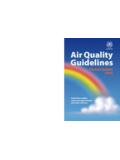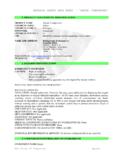Transcription of UMEx 100 DSD-DNPH
1 Page 1 of 32 T-1007-FV-01-0505-M Formaldehyde (Diffusive Samplers) Method no: 1007 Control no.: T-1007-FV-01-0505-M Target concentration: ppm ( mg/m3) OSHA PEL: ppm ( mg/m3) (TWA); 2 ppm ( mg/m3) (STEL) OSHA Action level: ppm ( mg/m3) (TWA) ACGIH TLV: ppm ( mg/m3) (ceiling) Procedure: Diffusive samples are collected by exposing either Assay Technology ChemDisk Aldehyde Monitor 571 (ChemDisk-AL), SKC UMEx 100 Passive Sampler (UMEx 100), or Supelco DSD-DNPH Diffusive Sampling Device ( DSD-DNPH ) to workplace air. Samples are extracted with acetonitrile and analyzed by LC using a UV detector. Recommended sampling time For UMEx 100, ChemDisk-AL, and DSD-DNPH : 240 min (TWA); 15 min (STEL) Reliable quantitation limit: RQL SEE* sampler (ppb) ( g/m3)(%) ChemDisk-AL UMEx 100 DSD-DNPH *For samples where sampling site atmospheric pressure and temperature are known.
2 When either or both of these values are unknown, see Section for applicable standard errors of estimate. Special requirements: Report sampling site atmospheric pressure and temperature when using diffusive samplers. Store samplers in a refrigerator both before and after sampling. For quantitative results, use an active sampling procedure such as OSHA Method 52 when monitoring exposures resulting from the use of formalin solutions. These diffusive samplers failed validation when formalin was the source of formaldehyde. (Section ) Do not use these diffusive samplers if the ozone level is greater than ppm. (Section ) Do not use these diffusive samplers if the humidity is 10% or less. (Section ) Place samples into manufacturer-supplied aluminized bags immediately after sampling. Status of method: Evaluated method.
3 This method has been subjected to established evaluation procedures of the Methods Development Team. May 2005 Mary Eide Methods Development Team Industrial Hygiene Chemistry Division OSHA Salt Lake Technical Center Sandy UT 84070-6406 Page 2 of 32 T-1007-FV-01-0505-M 1. General Discussion For problems with accessibility in using figures and illustrations in this method, please contact the author at (801) 233-4900. These procedures were designed and tested for internal use by OSHA personnel. Mention of any company name or commercial product does not constitute endorsement by OSHA. Background History The purpose of this work was to validate a diffusive sampler for formaldehyde. The 3M formaldehyde monitor 3721, used in OSHA Method ID-2051, adsorbed the formaldehyde onto a bisulfite-impregnated paper, and used chromotropic acid to detect formaldehyde.
4 These samplers could be used for only TWA sampling with a minimum of 4 hours sampled. The PEL for formaldehyde has a 2 ppm STEL, so a diffusive sampler that could measure STEL level was desired. The three diffusive sampling devices used in this method are Assay Technology ChemDisk 571 Aldehyde Monitor (ChemDisk-AL), SKC UMEx 100 Passive Sampler (UMEx 100), and Supelco DSD-DNPH Diffusive Sampling Device ( DSD-DNPH ). All three of these samplers use 2,4-dinitrophenyl hydrazine (DNPH), in the presence of a strong acid, to derivatize the formaldehyde into a unique derivative. Other aldehydes and ketones will form their own unique derivative. The analysis is by liquid chromatography (LC) with a UV detector at 365 nm. The sensitivity of these samplers was much greater than the bisulfite impregnated paper, so these samplers can be used for STEL sampling.
5 The reaction of the carbonyl containing chemical with DNPH to form the hydrazone derivative and water is shown below: In the case of formaldehyde R1 and R2 are hydrogens. The test atmospheres used in this work were dynamically generated by introducing the formaldehyde/water solution into a heated manifold, and then diluting the resultant vapor with a measured stream of air at a known flow, temperature, and humidity. The formaldehyde/water solution was freshly prepared by bubbling formaldehyde gas produced by heating paraformaldehyde into deionized water. A nitrogen gas stream carried the formaldehyde gas into the water. The concentration of the formaldehyde in solution was determined by titration following the procedure in OSHA Method This solution was stable for at least 1 week. Theoretical test atmosphere concentration was calculated from the test atmosphere generation parameters, and it was confirmed using OSHA Method The average of active sampling method results was of theoretical for side-by-side samples that were collected simultaneously for every diffusive sampler test.
6 Theoretical test atmosphere concentrations (verified by active sample results) were used in subsequent calculations. 1 Formaldehyde OSHA Method ID-205. (accessed 9/03/03). 2 Acrolein and/or Formaldehyde OSHA Method 52. (accessed 9/03/03). NNOOOONHNH2H+NOONOONHOH2NR1R2OR2R1++Page 3 of 32 T-1007-FV-01-0505-M Sampling test atmospheres generated using formalin (formaldehyde/water solution stabilized with methyl alcohol) at ambient temperatures can produce low results for diffusive samplers that have been calibrated with formaldehyde when compared to results from active samplers. This discrepancy has been cited in the literature and it was confirmed by experimental work performed in this method (Section ), and may be as much as 35%.
7 3,4 The root cause of the inconsistency is the reversible chemical reaction of formaldehyde and methyl alcohol to form primarily methoxymethanol and trace levels of Both formaldehyde and methoxymethanol react to form the formaldehyde derivative on reagent coated active and diffusive samplers. Methoxymethanol and dimethoxymethane have different diffusive sampling rates than formaldehyde. Sampling rate for diffusive samplers is dependant on the chemical being sampled, while sampling rate for active samplers is independent of the chemical being sampled, as the sampling rate is the flow rate of the sampling pump. This uncorrectable bias for formaldehyde diffusive samplers will always exist in workplaces where formalin is used, and may be greater than the accuracy requirement of 25% for TWA samples and 35% for STEL samples, required by the OSHA standard for For quantitative results, an active sampling procedure such as OSHA Method 527 should be used when monitoring exposures resulting from the use of formalin solutions.
8 The laboratory test atmosphere issue can be resolved by increasing the temperature of the vapor generator such that it is sufficient to reverse the formation of methoxymethanol and dimethoxymethane and accordingly reform formaldehyde. Diffusive and active sampling results from such a test atmosphere are similar. This effect was also confirmed in this work (Section ). Conditions in the workplace may not be sufficient to reverse the formation of methoxymethanol and dimethoxymethane, and their unknown proportions in workplace atmospheres can cause erroneous diffusive sampling results for formaldehyde. Ozone is an interference for samplers using DNPH derivatization. Ozone can react with the DNPH, decreasing the amount available for derivatizing the formaldehyde, or it can decrease the amount of formaldehyde-DNPH already Most urban pollution levels are below ppm ozone.
9 Tests of an atmosphere of ppm ozone showed a recovery of for ChemDisk-AL, for UMEx 100, and for DSD-DNPH . Higher ozone levels showed more of a loss (Section ). The diffusive samplers in this work performed best in relative humidities (RH) above 10% (Section ). At relative humidities lower than 10% the tested results were significantly lower when compared to theoretical. This indicates that water is a necessary component of the reaction between formaldehyde and DNPH. Storing samplers at elevated temperatures causes the DNPH to decompose, forming 2,4-dinitroaniline, which may co-elute with the DNPH-formaldehyde derivative. EPA recommends storing samplers both before and after sampling at 4 ,9 This 3 Pengelly, I, Groves, , Levin, , and Lindahl, R.
10 An Investigation into the Differences in Composition of Formaldehyde Atmospheres Generated from Different Source Materials and the Consequences for Diffusive Sampling, Ann. Occup. Hyg., 1996, Vol. 40, No. 5, pp 555-567. 4 Formaldehyde in Air, MDHS 78. (accessed 9/10/03). 5 Walker, J. Formaldehyde, Reinhold Publishing Corporation: New York, 1953, p 74. 6 CFR Formaldehyde. (accessed 9/03/03). 7 Acrolein and/or Formaldehyde OSHA Method 52. (accessed 9/03/03). 8 Compendium Method TO-11A, Determination of Formaldehyde in Ambient Air Using Adsorbent Cartridge Followed by High Performance Liquid Chromatography (HPLC). (accessed 4/15/04). 9 Compendium Method 0011, Sampling for Selected Aldehyde and Ketone Emissions from Stationary Sources. (accessed 4/15/04). Page 4 of 32 T-1007-FV-01-0505-M decomposition was also observed by NIOSH, a significant increase of a peak at the retention time of the formaldehyde-DNPH derivative was observed when DNPH coated silica gel air samplers were stored at 40 C (104 F) Toxic effects (This section is for information only and should not be taken as the basis of OSHA policy.)














